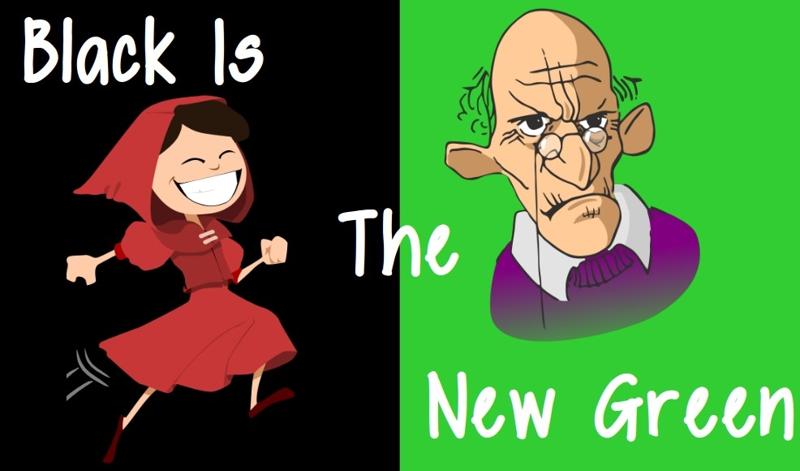
Nina: Nana, I’m ready for my meeting. What do you think of my costume? Nana: What on earth are you wearing on your head, and why are your clothes black? I thought your environmentalist girl group decided to wear green to every meeting. Don’t you call yourselves ‘The Little Mean Girls’?
Nina: The Little Green Girls, Nana. I didn’t realize you pay so much attention to my life. I’m flattered. We are supposed to wear green, but in today’s presentation I am making a point for which I need to wear black.
Nana: Really? What’s this presentation about?
Nina: It’s called ‘The Future is Black’.
Nana: Nina, the purpose of this group is for young people to brainstorm and look for solutions. Everyone already knows the future is bleak. You’re supposed to look for solutions that give hope.
Nina: But Nana, I said ‘The Future is Black’, not bleak. You need to get your ears checked.
Nana: Bleak, black, what’s the difference?
Nina: Everything. I think it’s racist to equate black to bleak. Why is black used to represent misery and evil, and white purity and hope? What’s so pure about white anyway? It’s a mixture of light of all possible wavelengths.
Nana: Black has a negative connotation fear because of the innate human fear of darkness, Nina. It’s not racist.
Nina: It is, Nana, as the extension to skin color is made without conscious thought in some cases. The negative connotation of black causes us to automatically assign negative qualities to dark skinned people.
Nana: Perhaps there may be something to that. I’ll have to think about it. But why is your future black? Shouldn’t it be green? This isn’t about black or white, it’s about green.
Nina: Ah, Nana, but I’ve been doing some research and black is the new green.
Nana: I hate this redefining of colors. First, there is some ridiculous TV show called Orange is the New Black and now you say, black is the new green, so is orange the new green? Ouch, that makes my head hurt.
Nina: You shouldn’t watch so much TV, Nana. You should read science articles, instead. Then you would know about the black fungus that has been growing in the water cooling pipes of the Chernobyl reactor.
Nana: Chernobyl!! That’s impossible. The radiation levels there are too high. In fact, even in February this year, when the Russian army invaded Ukraine, the disruption in the contaminated soil has caused a 20 fold increase in radiation levels there.
Nina: I know, but these fungi are radiotrophic. Scientists think it uses the radiation energy to prepare food, just like plants use sunlight during photosynthesis.
Nana: No way! You’re crazy. Radiation damages cells and causes cancer.
Nina: Evolution has developed a natural defense against radiation. Melanin in our body, protects us from the harmful ultraviolet rays of the sun. These fungi have evolved to develop some modified form of melanin, that renders better protection against radiation. But more interestingly, it seems that the fungi with such melanin are able to feed on the energy from the radiation.
Nana: Feed of radiation! Such nonsense.
Nina: It’s true, and awesome in two ways, Nana. One of the biggest problems with using nuclear energy today, is nuclear waste disposal. But if we have fungi that can metabolize the waste and make it less dangerous, then it may become feasible to use nuclear energy on a large scale.
Nana: Yikes! Nuclear energy gives me the heebeejeebies. It’s too dangerous. I mean haven’t we learned our lesson with Chernobyl?
Nina: We did, and that is why nuclear power plant technology has now matured and harnessing nuclear energy is a lot safer, now.
Nana: Perhaps. What’s the other advantage?
Nina: If these fungus can use melanin to convert harmful radiation into useful energy, perhaps we can figure out how and do the same. That would be an added and much needed source of energy.
Nana: So you’re saying, Melanin is Chlorophyll’s dark twin. Cool.
Nina: Yes. Dark, but not evil. Also, these fungi may help scientists cross a major hurdle hindering space travel.
Nana: What’s that?
Nina: Radiation exposure for astronauts.
Nana: What will they do? Grow mushrooms on the hulls of spaceships?
Nina: Exactly. So, astronauts are going to get high on mushrooms! Haha.
Nana: Amazing how we keep assaulting nature, but it keeps coming to our rescue. I can’t believe that even Chernobyl has a silver lining.
Nina: Evolution is so robust and persistent, I find it fascinating. The black fungus growing in Chernobyl isn’t really surprising. Have you heard of extremophile organisms?
Nana: Extremophile? Do you mean organisms like Tardigrades?
Nina: Tardigrades are an impressive variety of extremophiles, but there are many more including several types of bacteria and fungi. One of the fungus varieties found in Chernobyl is cryptococcus neoformans.
Nana: No way! Isn’t that a dangerous pathogen?
Nina: Very, especially to people with compromised immune systems. Over the years several medicines have been developed to combat it, and now it may actually come to our rescue. Funny, isn’t it, the way the world works?
Nana: Indeed. But not quite as funny as your puffy hat.
Nina:Hmmph. I’m dressed as a black mushroom, Nana.
Nana: And I don’t want an fungal infestation. Off you go. Out! Shoo.
This post is a part of the #NinaAndNana series I co-host with Lavanya Srinivasan. Her posts can be found here.